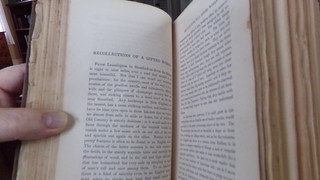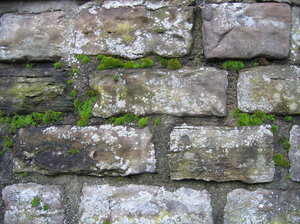
From the Hawthorne Tree
Bits and bobs about my cousin, Nathaniel Hawthorne
Read/Post Comments (3)
"Every individual has a place to fill in the world, and is important, in some respects, whether he chooses to be so or not."
~ Nath'l Hawthorne, Oct. 25, 1835, American Note Books
Hawthorne's Way with Words
Nathaniel Hawthorne, upon his return to America after an approximately six year stay in first Liverpool, England, acting as the U.S. Consulate there, and then in Italy, sat down to put his impressions of "Our Old Home" into book form. Here is my copy of that book.



Printed in 1863 - very fragile but precious to me.
Hawthorne has a way with words, and his description of the wild and natural beauty of the countryside going from Leamington to Stratford-on-Avon is poetry indeed.
At one point in his recounting of these observations, he says "The English should send us photographs of portions of the trunks of trees, the tangled and various products of a hedge, and a square foot of an old wall." If only he could have seen ahead to today when photographs abound of just the kind of natural beauty he was observing about the English country side some one hundred fifty years ago.
In Our Old Home, taken from the first portion of "Recollections of a Gifted Woman," here is Hawthorne's entry:
And just because you can never get too much of the English landscape, one more for the road...

Cheers for the written word but for the visual arts, as well!
Bex, From-the-Hawtorne-Tree
~ ~ ~ ~ ~ ~ ~ ~ ~ ~
Check out my other blog, "Thoughts from Crow Cottage" here.
Archives:
2014 Archives at JournalScape



Printed in 1863 - very fragile but precious to me.
Hawthorne has a way with words, and his description of the wild and natural beauty of the countryside going from Leamington to Stratford-on-Avon is poetry indeed.
At one point in his recounting of these observations, he says "The English should send us photographs of portions of the trunks of trees, the tangled and various products of a hedge, and a square foot of an old wall." If only he could have seen ahead to today when photographs abound of just the kind of natural beauty he was observing about the English country side some one hundred fifty years ago.
In Our Old Home, taken from the first portion of "Recollections of a Gifted Woman," here is Hawthorne's entry:
"From Leamington to Stratford-on-Avon the distance is eight or nine miles, over a road that seemed to me most beautiful. Not that I can recall any memorable peculiarities; for the country, most of the way, is a succession of the gentlest swells and subsidences, affording wide and far glimpses of champaign scenery here and there, and sinking almost to a dead level as we draw near Stratford.
Any landscape in New England, even the tamest, has a more striking outline, and besides would have its blue eyes open in those lakelets that we encounter almost from mile to mile at home, but of which the Old Country is utterly destitute; or it would smile in our faces through the medium of the wayside brooks that vanish under a low stone arch on one side of the road, and sparkle out again on the other.
Neither of these pretty features is often to be found in an
English scene. The charm of the latter consists in the rich verdure of the fields, in the stately wayside trees and carefully kept plantations of wood, and in the old and high cultivation that has humanized the very sods by mingling so much of man's toil and care among them.
To an American there is a kind of sanctity even in an English turnip-field, when he thinks how long that small square of ground has been known and recognized as a possession, transmitted from father to son, trodden often by memorable feet, and utterly redeemed from savagery by old acquaintanceship with civilized eyes.
The wildest things in England are more than half tame. The trees, for instance, whether in hedge-row, park, or what they call forest, have nothing wild about them. They are never ragged; there is a certain decorous restraint in the freest outspread of their branches, though they spread wider than any self-nurturing tree; they are tall, vigorous, bulky, with a look of age-long life, and a promise of more years to come, all of which will bring them into closer kindred with the race of man. Somebody or other has known them from the sapling upward; and if they endure long enough, they grow to be traditionally observed and honored, and connected with the fortunes of old families, till, like Tennyson's Talking Oak, they babble with a thousand leafy tongues to ears that can understand them.
An American tree, however, if it could grow in fair competition with an English one of similar species, would probably be the more picturesque object of the two. The Warwickshire elm has not so beautiful a shape as those that overhang our village street;
and as for the redoubtable English oak, there is a certain John Bullism in its figure, a compact rotundity of foliage, a lack of irregular and various outline, that make it look wonderfully like a gigantic cauliflower. Its leaf, too, is much smaller than that of most varieties of American oak; nor do I mean to doubt that the latter, with free leave to grow, reverent care and cultivation, and immunity from the axe, would live out its centuries as sturdily as its English brother, and prove far the nobler and more majestic specimen of a tree at the end of them.
Still, however one's Yankee patriotism may struggle against the admission, it must be owned that the trees and other objects of an English landscape take hold of the observer by numberless minute tendrils, as it were, which, look as closely as we choose, we never find in an American scene.
The parasitic growth is so luxuriant, that the trunk of the tree, so gray and dry in our climate, is better worth observing than the boughs and foliage; a verdant messiness coats it all over; so that it looks almost as green as the leaves; and often, moreover, the stately stem is clustered about, high upward, with creeping and twining shrubs, the ivy, and sometimes the mistletoe, close-clinging friends, nurtured by the moisture and never too fervid sunshine, and supporting themselves by the old tree's abundant strength. We call it a parasitical vegetation; but, if the phrase imply any reproach, it is unkind to bestow it on this beautiful affection and relationship which exist in England between one order of plants and another: the strong tree being always ready to give support to the trailing shrub, lift it to the sun, and feed it out of its own heart, if it crave such food; and the shrub, on its part, repaying its foster-father with an ample luxuriance of beauty, and adding Corinthian grace to the tree's lofty strength. No bitter winter nips these tender little sympathies, no hot sun burns the life out of them; and therefore they outlast the longevity of the oak, and, if the woodman permitted, would bury it in a green grave, when all is over.
Should there be nothing else along the road to look at, an English hedge might well suffice to occupy the eyes, and, to a depth beyond what he would suppose, the heart of an American. We often set out hedges in our own soil, but might as well set out figs or pineapples and expect to gather fruit of them. Something grows, to be sure, which we choose to call a hedge; but it lacks the dense, luxuriant variety of vegetation that is accumulated into the English original, in which a botanist would find a thousand shrubs and gracious herbs that the hedgemaker never thought of planting there. Among them, growing wild, are many of the kindred blossoms of the very flowers which our pilgrim fathers brought from England, for the sake of their simple beauty and associations, and which we have ever since been cultivating in gardens. There is not a softer trait to be found in the character of those stern men than that they should have been sensible of these flower-roots clinging among the fibres of their rugged hearts, and have felt the necessity of bringing them over sea and making them hereditary in the new land, instead of trusting to what rarer beauty the wilderness might have in store for them.

Or, if the roadside has no hedge, the ugliest stone fence (such as, in America, would keep itself bare and unsympathizing till the end of time) is sure to be covered with the small handiwork of Nature; that careful mother lets nothing go naked there, and if she cannot provide clothing, gives at least embroidery. No sooner is the fence built than she adopts and adorns it as a part of her original plan, treating the hard, uncomely construction as if it had all along been a favorite idea of her own. A little sprig of ivy may be seen creeping up the side of the low wall and clinging fast with its many feet to the rough surface;
a tuft of grass roots itself between two of the stones, where a pinch or two of wayside dust has been moistened into nutritious soil for it; a small bunch of fern grows in another crevice; a deep, soft, verdant moss spreads itself along the top and over all the available inequalities of the fence; and where nothing else will grow, lichens stick tenaciously to the bare stones and variegate the monotonous gray with hues of yellow and red.
Finally, a great deal of shrubbery clusters along the base of the stone wall, and takes away the hardness of its outline; and in due time, as the upshot of these apparently aimless or sportive touches, we recognize that the beneficent Creator of all things, working through his handmaiden whom we call Nature, has deigned to mingle a charm of divine gracefulness even with so earthly an institution as a boundary fence. The clown who wrought at it little dreamed what fellow-laborer he had.
The English should send us photographs of portions of the trunks of trees,
the tangled and various products of a hedge,
and a square foot of an old wall.
They can hardly send anything else so characteristic. Their artists, especially of the later school, sometimes toil to depict such subjects, but are apt to stiffen the lithe tendrils in the process.
The poets succeed better, with Tennyson at their head, and often produce ravishing effects by dint of a tender minuteness of touch, to which the genius of the soil and climate artfully impels them: for, as regards grandeur, there are loftier scenes in many countries than the best that England can show; but, for the picturesqueness of the smallest object that lies under its gentle gloom and sunshine, there is no scenery like it anywhere."
And just because you can never get too much of the English landscape, one more for the road...

Cheers for the written word but for the visual arts, as well!
Bex, From-the-Hawtorne-Tree
~ ~ ~ ~ ~ ~ ~ ~ ~ ~
Check out my other blog, "Thoughts from Crow Cottage" here.
Archives:
2014 Archives at JournalScape
Read/Post Comments (3)
Previous Entry :: Next Entry
Back to Top

.jpg)










